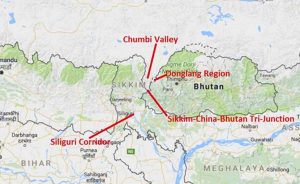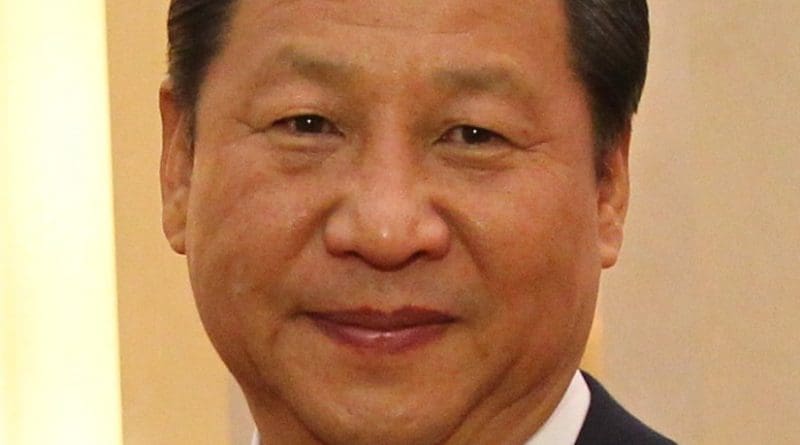Doklam Standoff And Chinese Vitriol: Is There An Internal Problem? – Analysis
By SAAG
By Bhaskar Roy*
The incessant vitriolic attacks on India from the Chinese official media, the foreign ministry and the defense ministry on the Doklam issue is becoming tiresome.
The tirade has included browbeating, insults and threat of military action to teach India a “bitter lesson”. The English language daily, Global Times can be called the “Rottweiler” of China’s media warfare machinery. ( Please see SAAG paper No. 6279, Dated 19-July-2017 for China’s “Three warfares ” strategy).
But media outlets like the Xinhua news agency,The People’s Daily, and The China Daily, as well as statements from Chinese foreign and defense ministries need to be taken seriously in India, because these are markers for India – China relations. These give the Indian government and Indian strategic community an insight into the mind of the Chinese Communist Party (CCP). Tiresome though the Chinese propaganda may be, there is a serious requirement not to brush things under the carpet, hoping China can be appeased . Some top advisors to the Indian government, with profound expertise on China stated that India’s first priority is China,its second priority is China, and its third priority is China .Yet a cautionary advice went with it – Do not provoke China. Once a CCP cadre told this writer that the “Chinese respect the strong and blackmail the weak”.

Prime Minister Narendra Modi walked the extra mile to embrace President Xi Jinping and China, to enhance bilateral relations and build trust . When Mr. Modi was entertaining Xi in Gandhinagar, Gujarat, in 2014, Chinese troops entered Indian territory, crossing the LAC . But Mr. Modi decided to put it aside and pursue his foreign policy based on friendship with all, including China and Pakistan. Pakistan it was known would be a difficult case, but China was expected to respond responsibly.
India’s firm stand on the Doklam issue has taken China by surprise, hence their disjointed response through the strategy of “Three warfares”. It is, therefore, not surprising that they have resorted to disingenuous fabrications. A senior diplomat in China’s foreign ministry, Wang Wenli told a visiting delegation of Indian journalists that Bhutan had conveyed to China through diplomatic channels that Bhutan had no claims on Doklam! But Bhutan’s demarche to China on June 29 released by the Bhutanese government in the public domain, pointed out that Doklam was Bhutanese territory disputed by China. China violated existing agreements by trespassing into the area. Bhutan asked the Chinese government to withdraw its troops to the pre- June 16 position and restore status quo. At Bhutan’s request,Indian troops went in, as per Article 2 of the India- Bhutan Friendship Treaty of 2007, that neither side shall allow its territory to be used for activities harmful to the other’s national security .
The threat to India’s Siliguri corridor, the narrow strip of land that joins the rest of India to its North- East is well known and need not be discussed here . But two points need to be red-flagged . Why is China so keen to get Doklam and give up its claims on other parts of Bhutanese territory?
It is well known that China has been fomenting unrest and separatism in North- East India for decades , starting from Naga leader Phizo’s visit to China in 1958 to as recently as the early 2000 s, supplying arms and ammunition to insurgent Naga, Assamese and other separatist groups . The larger plan is to dismember India, a plan unlikely to be discarded any time soon. The Chinese are apparently waiting for a government antagonistic to India to return in Bangladesh, when they can reactivate their strategy, having realized that the Myanmar route may no longer be available.
Whatever the Global Times may be seen as, it is a fact that this paper is a subsidiary of the CCP mouthpiece, The People’s Daily .No media outlet in China can be higher than The People’s Daily. According to the CCP constitution and the state constitution, the media comes under full control of the party and the state, and the party is supreme. Finally, President Xi has ordained that the media only serves the party and the state . All reports and stories are vetted politically before publication.
Hence, how do the Indian people and the government react when The Global Times (August 15) launches a blistering attack on Prime Minister Modi by name , accusing him of trying to derail China’s Belt and Road Initiative ( BRI ),of confronting China , seeking war,and pursuing hegemony in South Asia? The article also accuses India of disrupting BRICS, saying that BRICS has barely made any progress in recent years because of India’s policies. It has also charged that any international organization in which India has a significant say cannot play its due role.
Some concern has to be raised whether Mr. Modi will attend the upcoming BRICS summit in Xian, China, in September because of the Doklam issue. If he skips the Xian conclave and sends some lower level functionary ,China may lose face. It is unlikely however, that Mr. Modi will do such a thing , given the dignified silence that the government of India has demonstrated in the face of Chinese provocations, trying to draw India into a war of words. In his Independence Day (Aug 15) address to the nation, the PM did not touch upon Doklam or anything Chinese. The Chinese machinery must read that.
A more sensible comment comes from Li Qiayan of the China Institute of International Studies ( Xinhua, August 17 ). Li quoted an old Chinese proverb– “a good neighbor is better than a distant friend” adding “China has no desire to enter into a war with its neighbor”. In the same breath he went on to say that China and India are two developing giants with a wide range of common interests and a “sensible bilateral relationship will definitely benefit over two billion people”.
China has been blocking India’s strategic and security interests such as opposing India’s entry into the Nuclear Supplier’s Group (NSG), and putting a technical hold on listing Pakistan-based terrorist Masood Azhar in the UN terrorist list. Instead of screaming at China, India chose to engage China diplomatically. The question now arises – Is there something brewing in the country’s internal politics?
It defies logic why China took this action of entering Doklam at a time when the 19th Congress of the CCP is coming up later in the year. All party congresses are important because changes are made in the top echelons of the party, and policies are set forth. The 19th Congress, however, will be a landmark for Xi Jinping. He will not only start his second term, but may lay the foundation for a third term in 2022, breaking the established practice of two terms for the Party General Secretary. Xi has lined up his chosen successors to the five retiring from the Politburo Standing Committee (PBSC) and has chosen members for positions in the Politburo, as well as provincial heads and other important posts.
Xi has forcefully established himself as the most powerful leader of China after Mao Zedong. He has had himself declared as the “core” of the leadership, a concept which Deng Xiaoping, father of ‘reform and opening up’ had gradually diluted and dismantled. The visionary Deng and his colleagues, who were persecuted by Mao during the Cultural Revolution, realized too much power in one person could be disastrous for a nation. They decided on collective leadership. That appears to have been overturned by Xi.
Xi has sold to the people of China his “Chinese Dream” or rejuvenation of China to its old glory on a fast track. He, with the help of his trusted aides, floated the Belt and Road Initiative, which is both a strategic and economic initiative. With the Chinese economy beginning to slow down and domestic overcapacity building up, China has to go abroad. According to a recent IMF assessment, China’s domestic debt is on a dangerous path. Debt load could soar from 235 percent of GDP last year to 290 percent in 2022.
The BRI seems to be slowing down. Its flagship project, the China Pakistan Economic Corridor (CPEC) is being widely questioned in Pakistan. Chinese private companies are reluctant to invest in BRI or the CPEC. China needs India to join the BRI and invest in the CPEC. India’s refusal has angered Chinese officialdom and left them frustrated.
Xi has used the crackdown on corruption to mainly target his political enemies, both in the civilian and military sectors. This has caused problems,with people in both sectors nursing their grudge. Characteristically in China, they lie low when a big wave comes and bide their time. They have a long memory . And Xi is well aware of these things.
In the inner conclaves of the congress Xi may be questioned on many issues including economic down turn, job losses, high price rise, closure of factories and small businesses, and unpaid wages. China’s aggressive and threatening power projection has faced reverses.
Under these conditions would Xi Jinping have embarked on a misadventure like in Doklam?
In spite of the vast power that Xi Jinping has acquired, he still has not been able to bring down former top leader Jiang Zemin personally. Jiang’s vast network, through eroded by Xi,has not been wiped out.
Jiang loyalist PBSC member, Liu Yunshan is in charge of literary and propaganda work; hence the official media is under him. Earlier he had tried to trap Xi in Hong Kong affairs leading to the Occupy Central and Umbrella Movement campaigns . Similarly, he tried to set up Xi on Taiwan. Xi survived both, but internally he suffered some damage.
Xi Jinping also brought down two Vice Chairmen of the Central Military Commission, Xu Caihou and Guo Boxiong. Both were Jiang loyalists. And they would have their own loyalists in the PLA.
On the Doklam issue, both propaganda and the PLA are involved. India’s unilateral withdrawal has been set as the only condition for talks on the Doklam issue. Hence it is urgent that President Xi steps in and quietly does the needful, while saving face.
Damage, however, has been done to bilateral relations. China has lost trust among Indians, sadly.
*The writer is a New Delhi based strategic analyst. He can be reached at email [email protected]

